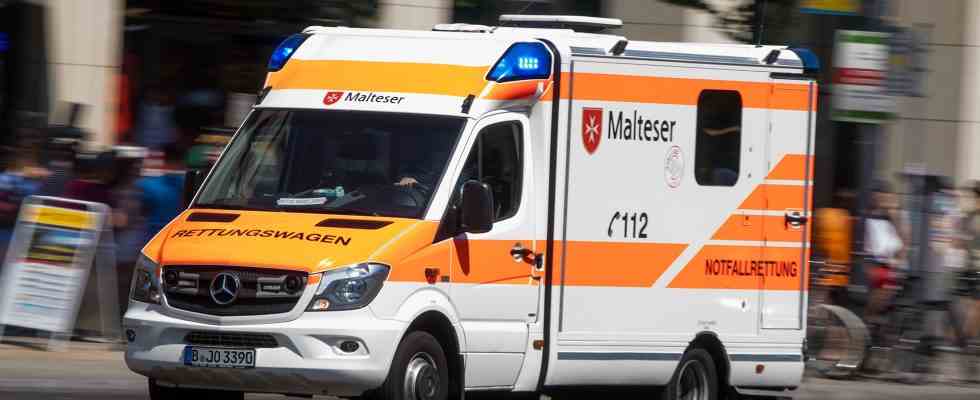Exclusive
Status: 03/14/2023 12:12 p.m
When it comes to rescue services, every minute counts – it’s often a matter of life or death. But more and more often they cannot keep to the times stipulated by the state. This is shown by research by BR Data and report Munich.
An operation in the evening: A woman collapsed at her doctor’s office, her heart is racing, her pulse is over 180. Emergency paramedic Markus Wagner sets off as quickly as possible with blue lights flashing. The woman urgently needs to go to the nearest hospital. An emergency – and yet routine for him.
However, one concern always resonates, even now, during an operation: hopefully there won’t be a second emergency call. Because Wagner drives the only vehicle in the area in the Lower Bavarian municipality of Schöfweg: a vehicle for three districts with 80,000 people.
When a second call comes in, a team from the neighboring precinct emergency room has to step in. Then there is no chance of meeting the 12-minute deadline. In Bavaria, ambulances should be on site within this time. The measurement starts as soon as the vehicle leaves in the direction of an emergency. The Bavarian Ministry of the Interior stipulates that this so-called assistance period should be observed in the so-called supply areas in 80 percent of all cases.
An evaluation of the ambulance service report 2022 shows: fewer and fewer ambulances can meet this time. While this applied to 92 percent of all operations throughout Bavaria in 2012, in 2021 it was only 87 percent.
problems especially in rural areas
In Bavaria, this is particularly due to the operations in rural areas. The data shows that while 95 percent of all rescue workers in cities with more than 100,000 inhabitants are still on time, only 76 percent of all workers in rural communities with fewer than 5,000 inhabitants manage to do so – the target value is therefore not reached.
Paramedic Markus Wagner has been on duty for more than 20 years, both in the city of Munich and in Lower Bavaria. He knows the problem: in the country it’s the long distances. Two missions in quick succession – or even at the same time – and the deadline is torn. Schöfweg is not an isolated case – only two thirds of all supply areas in Bavaria can meet the quota at all, one third takes longer than 12 minutes on average.
Different measurement methods
But the long distances in the country are not the only problem, as the analysis of BR Data and research of ARDpolitical magazine report Munich result. Many federal states provide figures that show the same trend: the quota is being met less and less often.
However, the values cannot be compared directly, because each federal state determines when the rescue team arrived on time. In Bavaria, the twelve minutes begin when the vehicle departs. In Berlin, for example, it’s only ten minutes – and the stopwatch is already running from the moment the emergency call center is called.
Nevertheless, the tendencies are the same everywhere. This is confirmed by Robert Pohl from the German fire brigade union, which is also responsible for rescue workers: the duration and number of operations have increased nationwide. As a result, it is becoming increasingly difficult to meet the specified rescue times.
Less than every second Berlin rescue operation in the limit
The most glaring example is Berlin. Here the rate at the fire brigade fell to 46 percent in 2021. Five years ago it was still 60 percent. The actual requirement of only needing more than ten minutes for every tenth mission – it has been missed for years.
In Berlin it is not the routes that are the problem, but the many missions where no team would actually be necessary. Haiko Luther is an emergency paramedic in the capital and estimates that an ambulance is actually not necessary in 50 percent of the cases. Because many people call the emergency doctor if they cut their finger in the kitchen, reports Luther. Instead of taking care of real emergencies, he sometimes feels like a taxi driver, his colleague confirms.
Lack of education a factor
The medical on-call service is actually responsible for many operations, not the emergency call. But the problems are actually too massive for a real question of guilt – and too numerous, says Robert Pohl from the fire brigade union: A lack of information about when 112 is the right number, complete overloading of the hospitals and the medical on-call service. Just tweaking a screw and just making a change in the emergency services only shifts a problem from A to B, he emphasizes. You have to improve all systems in the health system at the same time.
The Federal Ministry of Health is keeping a low profile. At a request from report Munich There is only one written answer: The ministry is currently preparing a reform of emergency care. In this way, the aim is to better interlink the various levels in the future. The ministry does not name concrete plans or even dates.
You can see this and other topics today at 9:45 p.m. on report Munich in the first.

